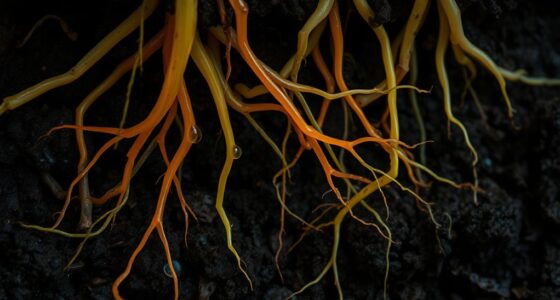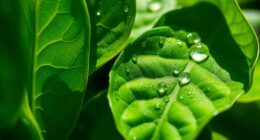During dry summers, some deciduous plants shed their leaves to conserve water and reduce transpiration. They develop deep roots that access underground water sources, even during droughts. These trees may produce seeds adapted to survive tough conditions or disperse to better areas. Shedding leaves and entering dormancy helps them conserve moisture and survive dry spells. Keep exploring to discover how these strategies help plants thrive despite harsh conditions.
Key Takeaways
- Shedding leaves reduces water loss through transpiration during dry periods.
- Entering dormancy conserves moisture and slows metabolic activities until conditions improve.
- Coordinated root deepening accesses underground water sources unavailable to surface roots.
- Producing seeds with dispersal adaptations ensures reproduction in more favorable, water-rich areas.
- These combined strategies enhance plant resilience and survival during drought-prone summers.

During periods of drought, many deciduous plants adopt specific strategies to survive water scarcity. One of the most essential tactics they use involves modifying their root systems. You’ll notice that these plants develop extensive, deep root adaptations that reach far below the surface, tapping into underground water sources that remain hidden during dry spells. These roots can extend hundreds of feet downward or spread laterally to access moisture from soil layers that stay moist longer. By doing so, they maximize water uptake during drought conditions, helping the plant conserve energy and maintain crucial functions. This deep-rooted strategy reduces reliance on surface water, which often dries up quickly when rainfall is scarce.
Deciduous plants develop deep roots to access underground water during droughts.
Another critical adaptation involves seed dispersal. When conditions turn harsh, deciduous plants often produce seeds capable of surviving drought periods and dispersing to more favorable environments. You might see seeds equipped with specialized structures like wings or buoyant coatings, designed to travel further away from the parent plant. These adaptations increase the chances of germination in areas with better water availability, ensuring the species’ survival across fluctuating conditions. The timing of seed dispersal is also strategic; many plants release seeds just before or during the onset of drought, allowing young plants to establish themselves quickly once the rainy season begins. This reproductive tactic minimizes the risk of seed loss during extended dry spells.
Shedding leaves is another key part of their drought management. When water becomes scarce, deciduous plants shed their leaves to reduce water loss through transpiration. This process conserves moisture within the plant’s tissues, helping it survive until more favorable conditions return. As the leaves fall, the plant enters a sort of dormancy, slowing down metabolic processes and conserving energy. This leaf loss isn’t permanent—once rains arrive and soil moisture increases, the plant will produce new leaves, resuming normal growth. By shedding leaves at the right time, these plants effectively minimize water loss and maximize their chances of enduring prolonged dry periods.
All these strategies—root adaptations, seed dispersal, and leaf shedding—work together to ensure deciduous plants survive droughts. You’ll observe that their ability to adapt in such ways isn’t random but a finely tuned response to environmental stress. They’ve evolved mechanisms to access water, reproduce in challenging times, and minimize water loss, making them resilient even in the harshest dry seasons. Understanding these adaptations gives you insight into how deciduous plants thrive despite limited water, showcasing nature’s remarkable ability to adapt and endure in changing climates.
Frequently Asked Questions
How Do Drought Deciduous Plants Recover After Shedding Leaves?
When drought deciduous plants shed their leaves, you might wonder how they recover. You’ll see photosynthesis restart as new leaves grow, capturing sunlight again. During dry periods, the plants rely on underground storage like roots and tubers to conserve energy and water. Once conditions improve, these reserves support the growth of new foliage, helping the plant recover and resume its normal functions efficiently.
Are Drought Deciduous Strategies Effective in Extremely Arid Environments?
Ever wondered if drought deciduous strategies truly work in extreme arid zones? You might think shedding leaves isn’t enough, but plants adapt with deep root systems and seed dormancy, allowing them to survive prolonged dryness. These root adaptations reach water sources, and seed dormancy ensures reproduction happens during favorable conditions. While not perfect, these strategies considerably enhance survival chances, making drought deciduous plants quite resilient even in the harshest environments.
Do All Plants in Dry Regions Adopt Deciduous Strategies?
Not all plants in dry regions adopt deciduous strategies. Some, like evergreens, develop adaptations such as thick, waxy leaves and needle-like structures to reduce water loss. Others rely on root retention, storing water in deep roots for drought periods. These evergreen adaptations help them survive harsh conditions without shedding leaves, unlike deciduous plants that drop leaves to conserve moisture during dry summers.
What Environmental Cues Trigger Leaf Shedding in Drought Deciduous Plants?
Imagine the landscape holding its breath as conditions change. You notice the plant sensing declining soil moisture and rising temperature fluctuations. These environmental cues signal it’s time to shed leaves, conserving precious water. You see leaves fall like whispers of survival, a silent response to the shifting environment. Drought deciduous plants rely on these cues—soil moisture levels and temperature changes—to trigger leaf shedding, ensuring their survival through harsh dry spells.
Can Drought Deciduous Plants Survive Without Any Leaves During Dry Periods?
You might wonder if drought deciduous plants can survive without leaves during dry periods. While leafless survival is challenging, some plants adapt by entering dormancy, reducing water loss and conserving resources. Without leaves, they minimize transpiration, allowing them to endure droughts longer. This strategy helps them survive until conditions improve, emphasizing the importance of water conservation even when leaves are shed.
Conclusion
So, as summer dries the landscape, your plants shed their leaves, turning to drought deciduous strategies just when you need them most. It’s a coincidence that losing leaves helps them survive, conserving water while waiting for rains to return. You’ll notice how nature’s timing, like a well-rehearsed dance, ensures these plants bounce back. In that quiet shedding, there’s resilience, a silent promise that after drought, life will bloom again, just as it did before.










